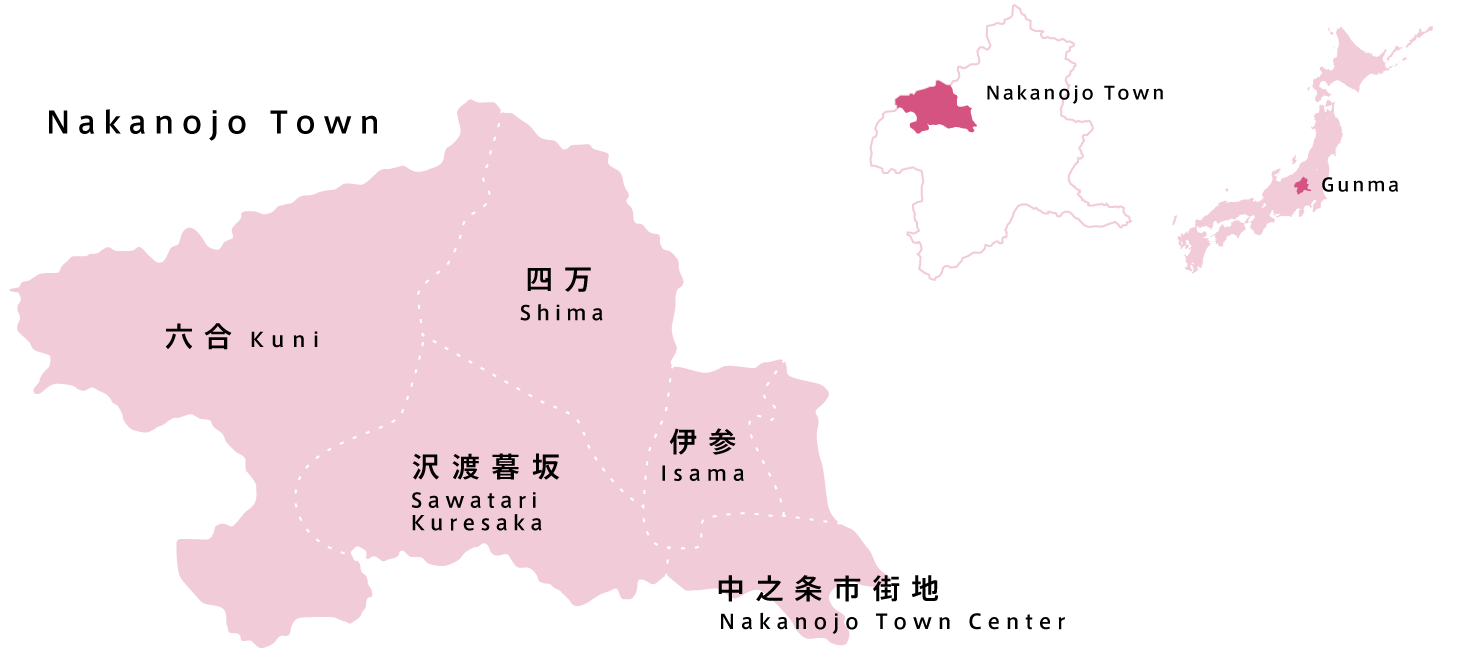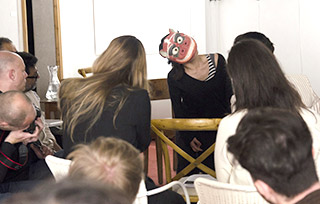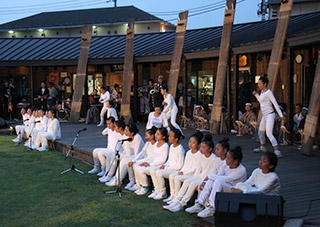The Nakanojo Biennale is an international contemporary art festival held every two years in Nakanojo Town, Gunma Prefecture. Surrounded by magnificent mountain scenery, Ramsar wetlands, hot spring villages with deep histories, sericulture, festivals, and traditional folk events, Nakanojo Town offers visitors the unique opportunity to experience beautiful satoyama culture that cannot be found anywhere else. Artists stay and work in this unique mountain village community and present their creations during the Nakanojo Biennale. For the tenth Nakanojo Biennale 2025, we are calling for a wide range of artists from Japan and abroad with innovative ideas and projects from various fields.
Artists - Nakanojo Biennale 2025
- Akihide Monna
- Akihiko Kuwayama
/ Taira Ichikawa - Akira Mizuno
- Akira Yanagisawa
- Amorn Thongpayong
- Anais-karenin
- Anita Gratzer
- Aquiles Hadjis
- Arthur Huang
- Atsuko Yamagata
- Ayano Kiho
- Chisato Tomokiyo
- Chonakan Chaithep
- Chuang Ho
- CLEMOMO
- Cristian Boffelli
- DamaDamTal
- Dennis Lin
- Eimi Aida
- Eliis Laul
- Elisa Malo
- Emu Nagasaka
- FUJIWARA Takahiro
- Haruka Yoshi
- Harumi Shimazu
- Haruna Sato
- HAYASHI Koshi
- Hiroko Tachihara
- Hiroshi Egami
- Hiroshi Miyazaki
- Hiroyuki Saito
- Hisanari Sugawara
- imoco
- Jiajun Lyu
- Josephine Turalba
- Kanade Hamawaki
- Kanako Akiyama
× Asako Hayashi - Kaori Miura
- Karin van der Molen
- Katsuyoshi Ogata
- Kazue Taguchi
- Kenichiro Ishiguro
- Kikoh Matsuura
- Komyo-Seisakujo
- Kosuke Nakagawa
- Kouichi Ohno
- Kuenlin Tsai
- Lee Kuohung
- Leung Mee Ping
- Lexygius Sanchez Calip
- Lily
- Maha Toya
- Mamoru Abe
- Manabu Hangai
- Marie Ikura
- Marin Harada
- Marino Kanda
- Masato Tanaka
- Masumi Saito
+ Guy Wigmore - Megumi Baba
- Mervy Pueblo
- Mia O
- Miharu Akiyama
- Mika Nakamura-Mather
- Mirai Seki
- Misa Funai
- Mitsuo Saiki
- Mitsuru Koga
- Miyuki Kido
- Momoko Noguchi
- MURATA Nozomi
- Nahoshi Tanaka
- Namae Myoji
+ Wataru Hayashi - Nao Matsunaga
- Naoto Nakamura
- Nobuharu Asano
- Nobuo Mitsunashi
- Noëll EL Farol
- Norio Suzuki
- Padungsak Kochsomrong
- Pirko Julia Schroeder
- Rica Ohya
- Rika Takahashi
- Ryuhei Sakurai
- Ryuichi Yahagi
- Samm Occeno
- SAN
- Sanae Yanagi
- Satoshi FUJIMORI
- Sayoko Suwabe
- Seki Ikonen
- Sena Park
- Shigeta Kobayashi
- SHINKA (Qinhua Yang)
- Shirane Kaizen School
- Shunpei Nagai
- Solongo Tseekhuu
- Sosuke Ueta
- Stella Zhang
- Taizen + Kimikimiyo
- Takafumi Ide
- Takami Motoki
- Takashi Kato
- Takashi Saie
- Takeru Toyokura
- Takumi Makino
- Tamas Szvet
- Tanya P Johnson
- Tatsunori Fujii
- Teresa Currea
- TETTA (Satoko Sugimoto)
- Theatre Akatsuki
- Thomas May
- Tomomi Hanzawa
- Tori Lab
- Toshiro Nagai
- Wannawit Patteep
- Wuttin Chansataboot
- Xiao Li
- Yasuaki Kudzumoto
- Yoshihiro Torigoe
- Yoshikuni Kimura
- Yoshinari Susaki
- Yoshiyasu Tamura
& Marfa Vasilieva - Youhei Fujinami
- Yuchi Hsiao
- Yuji Nishijima
- Yukiko Kasahara
Haruna Miyamori - Yumikio Sameshima
- Yusuke Muroi
- Yusuke Shikano
131 Artists / As of April 4, 2025
Open Days of the art festival:
Saturday, September 13 - Monday, October 13, 2025 (National Holiday)
9:30 - 17:00
*Open every day for 31 days
Location
At Gunma Prefecture, Nakanojo town.
Five areas of Nakanojo Town: Nakanojo Town Center, Isama, Shima Onsen, Sawatari Kuresaka, and Kuni. Venues include shopping streets, onsen towns, wooden school buildings, and old Japanese-style houses.

What's on
What's on: Nakanojo Biennale started in 2007 and this art festival marks it’s 10th year. Everywhere in town, including nearby onsen towns and abandoned wooden school buildings, will host exhibitions of drawings, sculptures, photographs and installations from more than 100 artists. There will be opening and closing events, music and performances as well as workshops and a market.
Access
Access to Nakanojo Station from Tokyo Station
Car: About 2.5 hours by highway
Train: About 3 hours by local train
Train: About 2 hours from *Ueno Station by express train
Bus: About 3 hours from Tokyo Station or **Shinjuku Bus Terminal (BASTA)
*Ueno Station is one stop from Tokyo Station
**Shinjuku Bus Terminal is 15 minutes by train from Tokyo Station
Access to Tokyo Station from the Airport
- Haneda airport to Tokyo Station - 30 minutes by train
- Narita airport to Tokyo Station - 1.5 hours by bus or train
Art and culture international exchange
Since 2007 Nakanojo Biennale has been encouraging cultural exchange between locals and artists, including international artists. Many artists have participated in traditional events or exchanged food cultures and I often hear they maintain a relationship as if they were family. Above all, I'm very happy the area has been so receptive and it seems like everyone is enjoying themselves.
Foreign artists have also moved to Nakanojo and it is giving more opportunities for people who live in mountain villages to interact with different cultures. It teaches us how we don't realise our unique local culture unless it's seen from an others perspective. Thus international art cultural exchanges play an important role in learning about our own culture.
 At Pavilion Zero, which took place at Venezia Biennale 2013, we were given an opportunity to screen a film which shows how Nakanojo approaches art; Also Masumi Saito (based in London) presented a performance inspired by the traditional dance form Shishi-Mai(Lion dance). From this experience I realised again how beautiful the culture from Nakanoyo is and I found it necessary to protect and share this culture with many others.
At Pavilion Zero, which took place at Venezia Biennale 2013, we were given an opportunity to screen a film which shows how Nakanojo approaches art; Also Masumi Saito (based in London) presented a performance inspired by the traditional dance form Shishi-Mai(Lion dance). From this experience I realised again how beautiful the culture from Nakanoyo is and I found it necessary to protect and share this culture with many others.
 Each time at the opening ceremony of Nakanojo Biennale we make a platform for local people and artists to collaborate. Performers are mainly local children and the music is played by local people who support the traditional music culture Gakudan (orchestra).
Each time at the opening ceremony of Nakanojo Biennale we make a platform for local people and artists to collaborate. Performers are mainly local children and the music is played by local people who support the traditional music culture Gakudan (orchestra).
They collaborate in completely different genres such as Jazz and Gagaku (ancient court music), contemporary dance and Kagura (sacred dance).Participants enjoy more than the audience and make theatre together.This is a very fascinating approach, we carry on our traditions and the collaboration between local people and internationally acclaimed artists allows us all to discover new art forms.
In 2014 we visited the little town of Acelum in northern Italy which, like Nakanojo, is listed as one of "The most beautiful villages". We inspected how they introduce art and culture through art or film festivals to the mountain village life, alongside beautiful nature.
It is not as convenient as city life but life amongst beautiful scenery has many similarities to the mountain village culture in Gunma.
Nowadays there is a trend that culture is originating in rural areas instead of cities, which are loosing their character, and many tourists are visiting to take advantage of this. I would like to shine a spotlight on local festivals and unknown customs which have roots in local people's lives, and to introduce more of the beautiful culture which has been passed on by many generations, not only the tourist spots like nature and hot springs.
I hope the local area will be full of pride and Nakanojo's original culture will be passed on to the next generation because of the art and culture international exchange program.
Contact us
Office of Nakanojo Biennale
TEL: +81-279-75-3320 (Japanese only, during weekday from 9:30a.m. to 5p.m. UTC+9 )
MAIL: office@nakanojo-biennale.com
Address: 〒377-0432 (Postcoode)
Gunma-ken, Agatsuma-gun, Nakanojo-machi, Gotanda 3534-4 Japan
